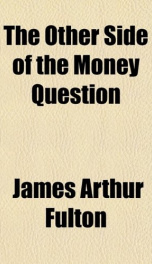the other side of the money question

Purchase of this book includes free trial access to www.million-books.com where you can read more than a million books for free. This is an OCR edition with typos. Excerpt from book: , CHAPTER II. EARLY ENACTIONS OF CONGRESS UPON MONEYFREQUENCY OF CHANGES PRESENT VARIETIES OF MONEY AND THEIR DIFFERENT LEGAL POWERSPECIFIC CONTRACTS NO OBSTACLE TO AC- TION BY CONGRESS. In accordance with such Constitutional powers, Congress has from time to time enacted many different measures and made many changes in monetary affairs. One of the laws passed ty Congress soon after the adoption of the Constitution was to provide for the establishment of a United States mint. The law was passed and approved iby President Washington in April, 1792. Philadelphia was selected as the location and the corner-stone was laid the same summer, such building being said to be the first one authorized to be erected for public use by the new government. At the suggestion of Jefferson, the decimal system of accounting was adopted by Congress, with the "dollar" as the "unit" and such system has continued unchanged to the present. The language used in the law establishing such system is highly significant and corroborates the view that those in charge thoroughly appreciated the fundamentally ideal nature of money. A section of the law says "That the money of account of the United States shall be expressed in dollars, or units; dimes, or tenths; cents, or hundredths; milles, or thousandths; a disme being the tenth part of a dollar; a cent the hundredth part of a dollar; a mille the thousandth part of a dollar; and that all accounts in the public offices, and all proceedings in the courts of the United States, shall be kept and had in conformity to this regulation." By action of Congress, gold, silver and copper were adopted as suitable metals to use in providing the people with a representative of the legal ideal money of account, in a form that enabled it to be circulated ...
Info about the book
Author:
Series:
Unknown
ASIN:
B0008CCNKU
Rating:
4.5/5 (3)Your rating:
0/5
Languge:
English
Users who have this book
Users who want this book
What readers are saying
What do you think? Write your own comment on this book!
write a commentif you like the other side of the money question try:
Other books by this author
Do you want to read a book that interests you? It’s EASY!
Create an account and send a request for reading to other users on the Webpage of the book!

